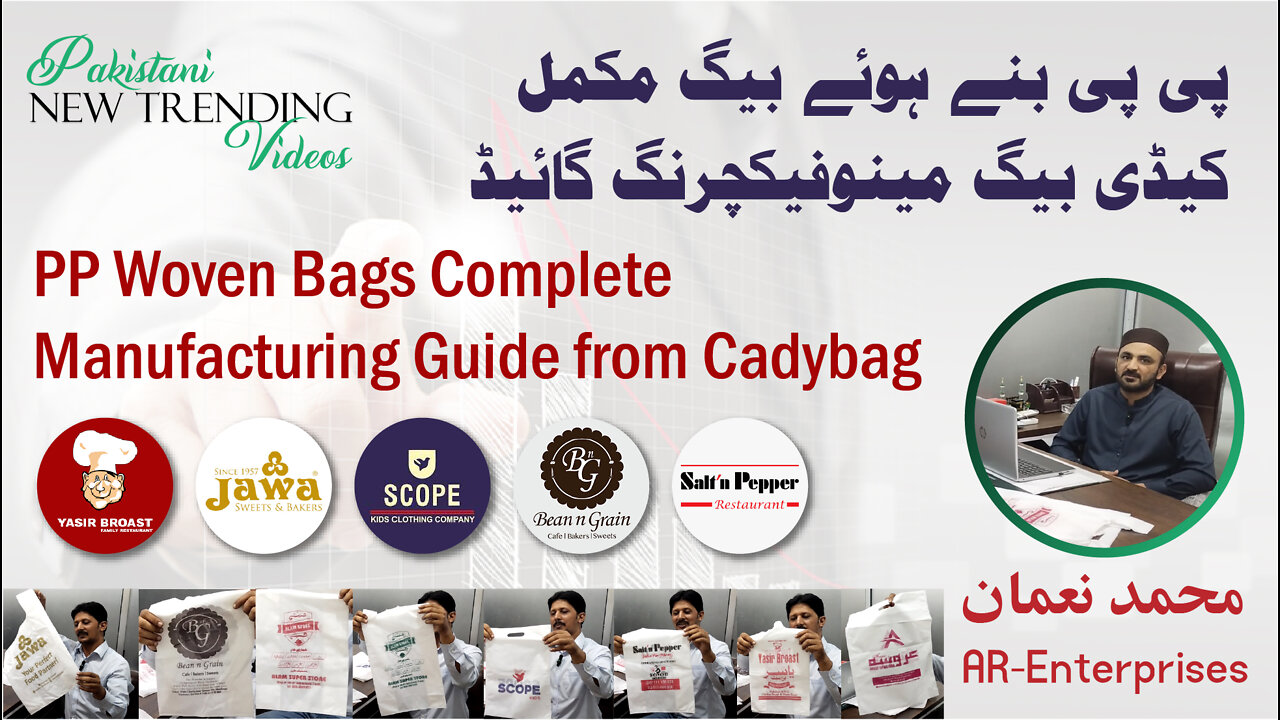Premium Only Content

PP woven Bags Manufacturing | Polypropylene Bags | Plastic bags |Manufacturing & Successful Business
PP woven Bags Manufacturing | Polypropylene Bags | Plastic bags | Manufacturing & Successful Business
Muhammad Nauman
AR Enterprises'
Everything You Need To Know About Polypropylene (PP) Plastic
What is Polypropylene (PP), and What is it Used For?
Polypropylene (PP) is a thermoplastic “addition polymer” made from the combination of propylene monomers. It is used in a variety of applications including packaging for consumer products, plastic parts for various industries including the automotive industry, special devices like living hinges, and textiles.
Polypropylene was first polymerized in 1951 by a pair of Phillips petroleum scientists named Paul Hogan and Robert Banks and later by Italian and German scientists Natta and Rehn. It became prominent extremely fast, as commercial production began barely three years after Italian chemist, Professor Giulio Natta, first polymerized it.
Natta perfected and synthesized the first polypropylene resin in Spain in 1954, and the ability of polypropylene to crystallize created a lot of excitement. By 1957, its popularity had exploded and widespread commercial production began across Europe. Today it is one of the most commonly produced plastics in the world.
According to some reports, the current global demand for the material generates an annual market of about 45 million metric tons and it is estimated that the demand will rise to approximately 62 million metric tons by 2020.
The major end users of polypropylene are the packaging industry, which consumes about 30% of the total, followed by the electrical and equipment manufacturing, which uses about 13% each. Household appliances and automotive industries both consume 10% each and construction materials follows with 5% of the market.
Other applications together make up the rest of the global polypropylene consumption.
Polypropylene has a relatively slippery surface which can make it a possible substitute for plastics like Acetal (POM) in low friction applications like gears or for use as a contact point for furniture.
Perhaps a negative aspect of this quality is that it can be difficult to bond Polypropylene to other surfaces (i.e. it does not adhere well to certain glues that work fine with other plastics and sometimes has to be welded in the event that forming a joint is required).
Although polypropylene is slippery at the molecular level, it does have a relatively high coefficient of friction - which is why acetal, nylon, or PTFE would be used instead. Polypropylene also has a low density relative to other common plastics which translates to weight savings for manufacturers and distributors of injection molded Polypropylene parts.
It has exceptional resistance at room temperature to organic solvents like fats but is subject to oxidation at higher temperatures (a potential issue during injection molding).
One of the major benefits of Polypropylene is that it can be manufactured (either through CNC or injection molding, thermoforming, or crimping) into a living hinge. Living hinges are extremely thin pieces of plastic that bend without breaking (even over extreme ranges of motion nearing 360 degrees).
They are not particularly useful for structural applications like holding up a heavy door but are exceptionally useful for non load-bearing applications such as the lid on a bottle of ketchup or shampoo. Polypropylene is uniquely adept for living hinges because it does not break when repeatedly bent.
One of the other advantages is that polypropylene can be CNC machined to include a living hinge which allows for faster prototype development and is less expensive than other prototyping methods. Creative Mechanisms is unique in our ability to machine living hinges from a single piece of polypropylene.
Another advantage of Polypropylene is that it can be easily copolymerized (essentially combined into a composite plastic) with other polymers like polyethylene. Copolymerization changes the material properties significantly, allowing for more robust engineering applications than are possible with pure polypropylene (more of a commodity plastic on its own).
The characteristics mentioned above and below mean that polypropylene is used in a variety of applications: dishwasher safe plates, trays, cups, etc, opaque to-go containers, and many toys.
https://www.creativemechanisms.com/blog/all-about-polypropylene-pp-plastic
#woven
#wovenstories
#wovencity
#wovenbusiness
#wovenbag
#bags
#bagswholesalemarket
#bagshopping
#bagswholesale
#bagshop
#bagsmanufacturer
#bagsewingtutorial
#bagsewingpattern
#bagsformen
#bagsbusiness
#cjdesign
-
 12:40
12:40
Scammer Payback
3 days agoHACKED Scammers Reaction to being Destroyed
3.97K10 -
 1:31:09
1:31:09
Badlands Media
19 hours agoEye of the Storm Ep. 208
46K11 -
 1:36:46
1:36:46
Kim Iversen
6 hours agoLee Harvey Oswald and Cuba: The New Evidence That Changes Everything
38.2K26 -
 2:19:43
2:19:43
TheSaltyCracker
4 hours agoCybertruck Bomber Manifesto Leaked ReeEEeE Stream 01-03-25
104K154 -
 1:44:12
1:44:12
Roseanne Barr
3 hours ago $8.32 earnedSquid Game? | The Roseanne Barr Podcast #81
35.4K23 -
 DVR
DVR
Man in America
8 hours ago🚨 2025 WARNING: Disaster Expert Predicts 'ABSOLUTE CHAOS' for America
10.9K12 -
 LIVE
LIVE
I_Came_With_Fire_Podcast
9 hours agoNew Years TERRORISM, Mexico trying to FAFO, and DARK MONEY to US Think Tanks
206 watching -
 1:47:40
1:47:40
Glenn Greenwald
6 hours agoThe Key Issues Determining the Trajectory of the Second Trump Administration: From Israel and Ukraine to Populism and Free Speech | SYSTEM UPDATE #382
52.3K35 -
 1:02:44
1:02:44
The StoneZONE with Roger Stone
3 hours agoRoger Stone Unveils His 16th Annual International Best and Worst Dressed List | The StoneZONE
20.4K3 -
 45:22
45:22
Kyle Rittenhouse Presents: Tactically Inappropriate
5 hours ago $2.45 earnedKyle Rittenhouse Presents: Tactically Inappropriate
26.1K14